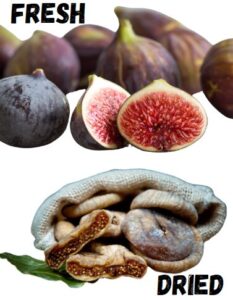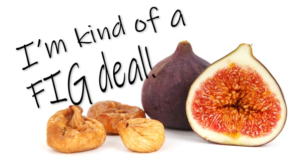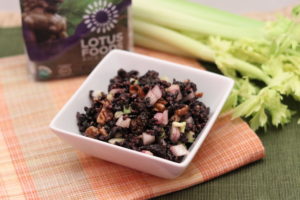What comes to mind when you think of figs?
The classic Fig Newton cookie?
I don’t know about you, but I used to group figs in the same category as prunes, and I wasn’t sure I liked them. For what it’s worth, I also used to put dates in this category – holy cow, was I wrong!
Before our REAL food journey, we avoided these foods, but like lots of other fruits and vegetables, now we LOVE them and CRAVE them!
If you’re not familiar with figs, they are both nutritious and delicious – and have an amazing flavor and texture. So, let’s take a closer look!
What are figs?
 Figs grow on ficus trees and have been around for a REALLY long time. Believe it or not, it’s estimated that wild fig trees actually grew in the dinosaur era, over 100 million years ago! Figs may even be the first food harvested by humans. There are many Biblical references to fig trees, and many believe the forbidden fruit in the Garden of Eden was actually a fig (not an apple).
Figs grow on ficus trees and have been around for a REALLY long time. Believe it or not, it’s estimated that wild fig trees actually grew in the dinosaur era, over 100 million years ago! Figs may even be the first food harvested by humans. There are many Biblical references to fig trees, and many believe the forbidden fruit in the Garden of Eden was actually a fig (not an apple).
They are somewhat unique because they don’t come from a flower. Instead, they are the flower. So, technically, figs are flowers, not fruits. And there are hundreds of tiny flowers that grow inside the figs…these edible seeds give them their unique texture.
Turkey is the largest global producer. For figs grown in the U.S., well over 90% (and close to 100% of dried figs) come from California. There are many varieties, with the two most common being Golden figs and black Mission figs (the dark, sweet variety you often find). Just in case you were wondering, the priests of the Mission San Diego planted fig trees in the 1700s, which is why they are called “Mission” figs.
Why figs?
Like all fruits and vegetables, they are loaded with beneficial nutrients:
- Low in calories — only 20-40 calories per fig!
- Good source of fiber, vitamins and minerals.
- Contain antioxidants, which help prevent and fight chronic disease.
- Their potassium helps reduce blood pressure and they contain respectable amounts of calcium, iron, manganese and zinc.
- Aid in digestion and can serve as a natural remedy for constipation and indigestion.
- The first Olympians included figs as an integral part of their training routines. Even today, some endurance athletes include them as part of their routine because of their portability and energy they provide.
- Can help kick sweet cravings! We know someone who, along with eating a variety of REAL food, included a daily fig to help kick her voracious baked goods habit. Not only did she lose weight, but her cholesterol is down 50 points!
Dried or fresh?
 Fresh figs have two seasons, one in early summer (May and June) and another harvest in late summer and early fall. Unfortunately, they only last about a week after harvest, which is why most figs are sold as dried. If you live in a part of the country where fresh figs are hard to find, your best bet is to find a local farmer who harvests their own figs and try to work out a deal!
Fresh figs have two seasons, one in early summer (May and June) and another harvest in late summer and early fall. Unfortunately, they only last about a week after harvest, which is why most figs are sold as dried. If you live in a part of the country where fresh figs are hard to find, your best bet is to find a local farmer who harvests their own figs and try to work out a deal!
Even if fresh figs aren’t available, dried figs are a great option. Their nutrition isn’t dramatically different, and they provide a sweet, concentrated flavor. Plus, they are available year-round.
How do you select and store figs?
If you can find fresh figs, look for a vibrant, rich color. You want them to be plump, with no bruises or broken skin. They should have a mild aroma. If they smell sour, they are likely starting to spoil. Use them quickly, as they don’t stay fresh for long after harvesting.
For dried figs, you can purchase them packaged or in bulk. If you purchase them in bulk, make sure they are clean and mold-free. Like fresh figs, their aroma should be sweet, not sour. For packaged figs, you can store them in a cool, dry place, and then keep them refrigerated once you have opened the package.
What can you do with them?
Keep it simple and combine them in a Ziploc bag with walnuts or almonds — they make an economical, nutritious and delicious snack, anytime of the day! Or try offering them up on your next cheese tray, along with grapes…their flavors complement one another beautifully.
Then, it’s time to get cooking!
Figs provide spectacular flavor and texture and are excellent in both sweet and savory dishes. They pair especially well with salty flavors, such as Greek kalamata olives and various types of cheese. We love figs in salads, pasta, pizza, grilled cheese, toppings for meats, oatmeal, smoothies, energy bites and so much more! Plus, they are excellent in baked goods, because they help retain moisture.
A few of our favorite recipes:
Super Immune-Boosting Citrus Salad
Caramelized Onion, Fig and Gorgonzola Pizza
Panzanella Kale Salad with Corn and Figs
Butternut Squash and Fig Pasta
Sweet ‘N Savory Grilled Portobellos, Tomatoes and Corn
Grape, Fig and Walnut Salad with Simple Vinaigrette
Lamb and Quinoa Salad with Honey Mustard Vinaigrette
Some other tips:
- Placing dried figs in the freezer for an hour can make them easier to slice.
- When slicing or dicing, you can rinse your knife under warm water if it becomes too sticky.
- Dried figs are a good substitute for dried dates in many recipes (and they are higher in fiber and lower in sugar).
- You can reconstitute (or soften) dried figs by soaking them in warm water until soft. Even when reconstituted, they will still be different than fresh figs, but are great for stews, cobblers, salads, appetizers and more.
We hope this inspires you to incorporate figs into one of your meals this week!
If you have a favorite fig recipe or tip, please share!
 LEARN MORE ABOUT THE NAPKIN!
LEARN MORE ABOUT THE NAPKIN!



I didn’t try figs until I was in my 30s. Boy, did I miss out! My favorite thing to pair it with is goat cheese. I used to put goat cheese and fig spread on crepes. Mmm…
I love your pizza recipe. In fact, I need to put that on the menu again soon!